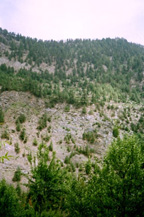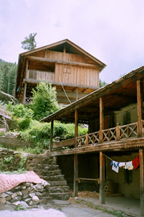On a trail of the Ganga -PART V
-Saraswati Kavula
 My next stop was at Harsil, which is a small village some 25 kms down from the Gangotri, a very quite and laid back place, normally preferred by
campers and people who look for some time away from the “madding crowds”. On the bus from Gangotri to Harsil, my fellow passenger Bhargav narrated me the story of how the Gangotri temple was built by the Raja of Nepal in 1815, “before this temple, there was
nothing in this region”. Slowly, the visitors started increasing in numbers. “It was in the last twenty years that the place got congested and also the Glacier began to get affected”, remarked a local CID officer, working at Harsil. He didn’t wish for his
name to be mentioned. I chanced to meet him, on my way to the riverside, when I passed through a small inner lane, and on seeing a traditional house, I stopped. The resident was the CID man who was on deputation to Uttaranchal.
My next stop was at Harsil, which is a small village some 25 kms down from the Gangotri, a very quite and laid back place, normally preferred by
campers and people who look for some time away from the “madding crowds”. On the bus from Gangotri to Harsil, my fellow passenger Bhargav narrated me the story of how the Gangotri temple was built by the Raja of Nepal in 1815, “before this temple, there was
nothing in this region”. Slowly, the visitors started increasing in numbers. “It was in the last twenty years that the place got congested and also the Glacier began to get affected”, remarked a local CID officer, working at Harsil. He didn’t wish for his
name to be mentioned. I chanced to meet him, on my way to the riverside, when I passed through a small inner lane, and on seeing a traditional house, I stopped. The resident was the CID man who was on deputation to Uttaranchal. 
“I come from Lucknow, but I have been here a long time’. The CID officer told me, I was surprised, ‘this is such a quite place, what work do you have
here?’ ‘This is the inner line limit, and is on the Chinese border, so we conduct joint exercises with the Border Security Forces”. I asked if I could look around the house, to which he agreed. ‘There don’t seem to be many of these traditional houses left
now, I see mostly the modern concrete structures everywhere and somehow, they seem out of place in this region. They surely seem unnatural and are almost like eyesores!’ I remarked. My host agreed, ‘these traditional houses were built with wood and since this
is an earthquake prone area, this sort of construction agreed with this region’. ‘Isn’t the concrete construction, bad for this region, I mean, it is unsafe in the case of earthquakes no?’ I asked him. ‘Yes, that is true, but since the Uttaranchal state has
been reinstated, there has been a ban on logging, thus, more and more houses and new buildings are being made with RCC concrete structures’. One cannot say what has reduced the forest cover, the locals constructing their homes with wood, or the clearing of
forests to make new hotels, apple orchards, and of course the blasting of the mountain side for construction of projects.
Our talk turned towards the future of the Glacier. My host agreed, ‘there has been an affect on the glacier, and on the water flow in the Ganga too.’
I remembered the bus passenger Bhargav’s words, ‘I don’t think the Ganga will ever dry up, the place from which it comes out is a ‘shakti sthal’ (place of divine powers), that will never loose its power.’ I mentioned this to the CID man. ‘Why, the glacier
has been receding, since 1962 the Glacier has receded by nearly 1.25 kms. If we do not recognise the problem, then we are blind. Right now, in Pauri District there is a shortage of water, people are being supplied water in tankers. The District Commissioner
has refused to stay in Pauri town. Tomorrow, it will be the same fate in other parts of Uttaranchal’. I told him that people including scientists sometimes dismiss ‘global warming’ as a fear psychosis. He disagreed, I have been living in these areas for so
many years, earlier, the summer temperatures in the 80’s never crossed 18 degree Celsius, and today they are touching 24 degrees. There has been hardly any snowfall for 4-5 years, but last year in 2005, it snowed continuously for one whole month from 16 January.
There was 10 feet snow; we never saw so much snow here.’
The guide books speak about the legend of an English man, Wilson, on how he had built the bridge across the Ganga near Mukhba village (3kms from Harsil)
and the villagers were too scared to get on the bridge and he hopped on to his horse and trotted up and down the bridge to allay their fears. As I asked details on this, my host smiled, ‘Wilson was running away from the British government, he sought refuge
with the local Raja and asked him for some land. The Raja told him to take which ever part of the land he wants. Wilson came here and started logging timber. The river was a good way for him to send the logs. That is how most of the Deodhar forests got logged
and taken away. Thanks to his initiative, timber logging and smuggling thrived in these areas. But of course, potatoes and apples grown in this region are his contribution. He was the one who introduced them in this region. But see today, most forest is being
cut by the local people to make apple orchards. It is illegal, but then there is poverty too. Most of the time, they are pawns in the hands of the big traders. Ten years ago, if you had come here, you could have seen thick forests, all around, the way you
see on this side, (he pointed to one mountain) today it is all gone. Only a few places it sustained due to the efforts of the local forest department’.
I walked back through to the village square, though Harsil is a remote village, many things are available that tourists demand – colas, mineral water,
Chinese, continental food you name it, you have it. I asked my hotel owner, ‘you have so much fresh water here, why do you sell all these colas and packaged water, isn’t all this adding to the trash in your area and destroying nature?’
‘What to do? Five years ago, if you came here, there was neither cold drink, nor packaged water available here.
But the tourists are always demanding, they ask all these things, which are in fact, difficult to be transported up here. So, for business sakes, we are forced to keep them here’. And the grassland near the riverside was littered with loads of plastic
bottles, carry bags, packaging wrappers. The mules were eating leftovers from the trash. I was reminded of the numerous animals in my city which die everyday, consuming hazardous waste materials along with the food in the trash bins. That day may not be far
off here too.
 There were some travellers from my city, fattened with prosperity, they did not wish to tax their bodies, and preferred to stop their visit at Gangotri. I assured
them that there is nothing much for them to “see” at Gomukh. They felt happy on hearing that, ‘why trouble the body and travel 40kms?’ The head of the group, who was a grain and clothes merchant from Hyderabad, asked the hotel manager, ‘how can people live
here, in this cold climate and without any sort of “comforts”? The hotel man replied, ‘well sir, here even if a man earns 100 rupees a month, he will enjoy his four cups of tea in a day, eat to his heart’s content, is able to work hard and stay fit and gets
a peaceful nights’ sleep. And if he doesn’t have money, his neighbours will feed him. I am sure that doesn’t happen in your big city’. To which, our big businessman did not have an answer.
There were some travellers from my city, fattened with prosperity, they did not wish to tax their bodies, and preferred to stop their visit at Gangotri. I assured
them that there is nothing much for them to “see” at Gomukh. They felt happy on hearing that, ‘why trouble the body and travel 40kms?’ The head of the group, who was a grain and clothes merchant from Hyderabad, asked the hotel manager, ‘how can people live
here, in this cold climate and without any sort of “comforts”? The hotel man replied, ‘well sir, here even if a man earns 100 rupees a month, he will enjoy his four cups of tea in a day, eat to his heart’s content, is able to work hard and stay fit and gets
a peaceful nights’ sleep. And if he doesn’t have money, his neighbours will feed him. I am sure that doesn’t happen in your big city’. To which, our big businessman did not have an answer.
(Photographs Saraswati Kavula)
( To be continued)